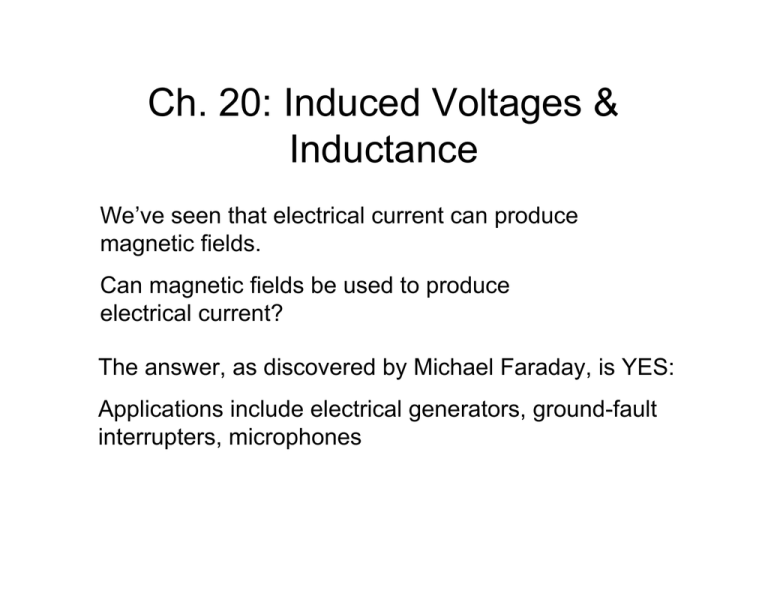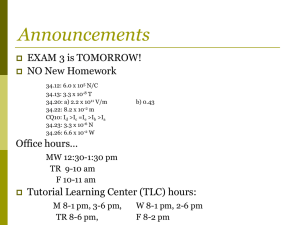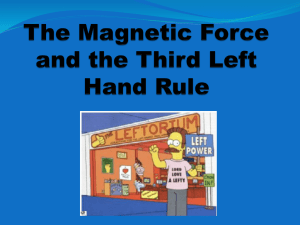Ch. 20: Induced Voltages & Inductance
advertisement

Ch. 20: Induced Voltages & Inductance We’ve seen that electrical current can produce magnetic fields. Can magnetic fields be used to produce electrical current? The answer, as discovered by Michael Faraday, is YES: Applications include electrical generators, ground-fault interrupters, microphones Faraday’s Experiments Faraday’s Experiments +1 Close switch: immediately after switch closed, ammeter measures current in secondary circuit Faraday’s Experiments After the switch has been closed for a while, ammeter has returned to zero. Faraday’s Experiments –1 Open switch: immediately after opening switch, ammeter registers a current in the OPPOSITE direction Faraday’s Experiments After the switch has been opened for a while, ammeter has returned to zero. Conclusions from Faraday’s experiment: B-field going from OFF to ON-- induces a current in secondary circuit B-field going from ON to OFF -- induces a current (opposite sign) in secondary circuit. B-field level constant (zero or non-zero) -- no current induced! Conclusion: The B-field itself does not induce any current -- only a CHANGE in B-field. Electromagnetic Induction While a magnet is moving toward a loop of wire, the ammeter shows the presence of a current While the magnet is held stationary, there is no current While the magnet is moving away from the loop, the ammeter shows a current in the opposite direction Electromagnetic Induction If the magnet is held stationary and the LOOP is moving, you get the same effect. A current is induced whenever there exists RELATIVE motion between the magnet & loop. Direction of current depends on direction of motion. Magnetic Flux Assume B-field is uniform. Area of loop = A. Magn. Flux ΦB through an area A: ΦB = B⊥A = BAcosθ SI unit: Weber (Wb) = T×m2 ΦB is proportional to the total number of lines passing through the loop Magnetic Flux Edge view of loop in uniform B-field: θ=0º: ΦB is maximized: ΦB = BA θ=90º: ΦB is zero Change B-field direction so θ=180º: ΦB = –BA ΦB & ΔΦB ××××× ××××× ××××× Example: A hexagon-shaped loop with area 0.5 m2 is placed in a uniform B-field of 2 T such that the loop’s normal is parallel to B. Calculate ΦB. ΦB1 = BAcosθ = BAcos0º = (2T)(0.5 m2) = 1.0 Wb Suppose the B-field strength is halved. Calculate ΦB now. Calculate ΔΦB. ΦB2 = ΦB1/ 2 = 0.5 Wb ΔΦB = ΦB2 – ΦB1 = (1.0–0.5)Wb = 0.5 Wb ΦB & ΔΦB ××××× ××××× ××××× Example: Go back to B=2.0 T. Suppose the loop is rotated 45° as shown. Calculate ΦB & ΔΦB. ΦB2 = BAcosθ = BAcos45º = (2T)(0.5 m2)(0.707) = 0.707 Wb ΔΦB = ΦB2 – ΦB1 = (1.0-0.707)Wb = 0.293 Wb No magnetic monopoles If we were to apply an analog of Gauss’ law to MAGNETIC field lines for a Gaussian surface in any region of space, we’d find: No magnetic monopoles means there’s no “magnetic charge” to enclose All B-field lines which enter the surface, must also leave it. So net ΦB is zero. FARADAY’S LAW OF MAGNETIC INDUCTION The instantaneous EMF induced in a circuit equals the time rate of change of MAGNETIC FLUX through the circuit If a circuit contains N tightly wound loops and the magn. flux changes by ΔΦB during a time interval Δt, the average EMF induced is given by Faraday’s Law: ΔΦ B ε = −N Δt FARADAY’S LAW OF MAGNETIC INDUCTION ΔΦ B ε = −N Δt ΦB = BAcosθ So EMF can be induced by changing any of B, A or θ. B: increase/decrease B-field strength A: change area of loop inside B-field ××××× ××××× ××××× ××××× ××××× ××××× θ: rotating coil in the field. ××××× ××××× ××××× ××××× ××××× ××××× A singular circular coil with a radius of 20 cm is in a B-field of 0.2 T with the plane of the coil perpendicular to the field lines. If the coil is pulled out of the field in 0.30 s find the magnitude of the average emf induced during this interval. ε = –N ΔΦB/Δt = –N (ΦB2 – ΦB1) / Δt ΦB1 = BA = (0.2T)(π(0.2m)2) = 0.025 Wb ΦB2 = 0 N=1 ε= 1(0.025Wb)/(0.3s) = 0.084V. Another example: A 25-turn circular coil of wire with a diameter of 1.0 m is placed with its axis aligned with the Earth's B-field, which has a magnitude of 0.5×10–4 T = 0.5G. During a time interval of 0.2 s, it's flipped 180º. What's the magnitude of the average EMF generated during this time? ΦB1 = BA ΦB2 = –BA ΔΦB = ΦB2 – ΦB1 = –2BA ε= –N ΔΦB/Δt = –25(2BA)/Δt ε = –25(2)(0.5×10–4 T)(π(0.5m)2) / 0.2 s ε = 9.8×10-3 V. Application: Electric Guitars B I changing magnetic flux induces voltage in pickup coil Microphones / acoustic pick-ups (me in 1998, BTW) microphones.audiolinks.com Ground Fault Interrupters Ground Fault Interrupters I If a connection to ground is accidently made… Ground Fault Interrupters I … the ground fault interrupter shuts off the device Ground Fault Interrupters Under normal operation, I1 & I2 are equal and opposite. Net Bfield through Fe ring is zero. Ground Fault Interrupters × But if there’s a short … Ground Fault Interrupters × … wire 1 induces a net B-field in Fe ring Ground Fault Interrupters × … wire 1 induces a net B-field in Fe ring The sudden increase in B induces a current in sensing coil, which triggers the circuit breaker Lenz’s Law: ΔΦ B ε = −N Δt Determines the direction the induced current flows. The current caused by the induce EMF travels in the direction that creates a magnetic field whose flux OPPOSES the CHANGE in the original magnetic flux. i.e., the induced current will flow to try to maintain the original magnetic flux thru the loop. Lenz’s Law: Induced B-field Bind “shores up” original ΦB if original ΦB is shrinking with time, or opposes the original ΦB if original ΦB is growing with time. Bind Borig S N ΦB increasing with time. Bind points in opposite direction to Borig. Lenz’s Law: Induced B-field Bind “shores up” original ΦB if original ΦB is shrinking with time, or opposes the original ΦB if original ΦB is growing with time. Bind Borig S N ΦB decreasing with time. Bind points in same direction to Borig. Lenz’s Law: Induced B-field Bind “shores up” original ΦB if original ΦB is shrinking with time, or opposes the original ΦB if original ΦB is growing with time. N Borig Bind S ΦB (now defined as flux towards the left) is decreasing with time. Bind points in same direction to Borig. Lenz’s Law: Induced B-field Bind “shores up” original ΦB if original ΦB is shrinking with time, or opposes the original ΦB if original ΦB is growing with time. N Borig Bind S ΦB (now defined as flux towards the left) is increasing with time. Bind points in opposite direction to Borig. Example 20.2 Given: a square coil with 25 turns. Each side is 1.8cm. The total resistance of the coil 0.35Ω. A uniform B-field is applied in the +z direction. a) If B changes from 0 T to 0.5 T in 0.8 s, find εind. First, find ΦBinitial & ΦBfinal: ΦBinitial = BinitA cos0º = 0 ΦBfinal = BfinalA cos0º = 0.5T(0.018m)2 = 1.62×10-4 Wb ΔΦB = Φbfinal – ΦBinitial = 1.62×10-4 Wb Then use Faraday’s Law: εind = –N ΔΦB/Δt= –25(1.62×10-4 Wb) / 0.8s = –5.06×10-3 V Example 20.2 Given: a square coil with 25 turns. Each side is 1.8cm. The total resistance of the coil 0.35Ω. A uniform B-field is applied in the +z direction. b) Find the magnitude & direction of the current induced while the field is changing. Use Ohm’s Law to find the magnitude of I I = ΔV/R = 5.06×10-3 V / 0.35Ω = 1.45×10-2 A The direction is found from Lenz’s Law: B is increasing up through the loop. ΦB is also positive and increasing. The induced B-field will thus point downward. The induced current will circulate clockwise (right-hand rule with thumb pointing downward). Example 20.2 Given: a square coil with 25 turns. Each side is 1.8cm. The total resistance of the coil 0.35Ω. A uniform B-field is applied in the +z direction. b) Find the magnitude & direction of the current induced while the field is changing. Use Ohm’s Law to find the magnitude of I I = ΔV/R = 5.06×10-3 V / 0.35Ω = 1.45×10-2 A The direction is found from Lenz’s Law: B is increasing up through the loop. ΦB is also positive and increasing. The induced B-field will thus point downward. The induced current will circulate clockwise (right-hand rule with thumb pointing downward).






